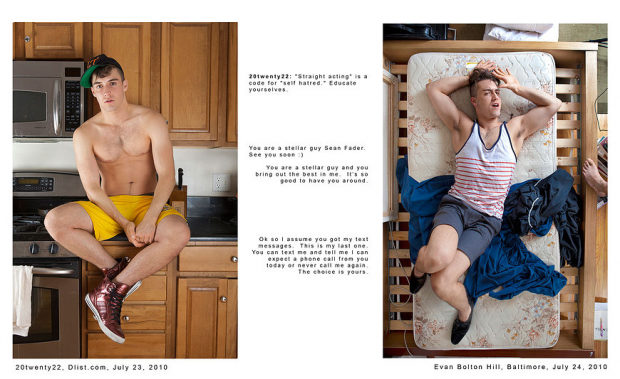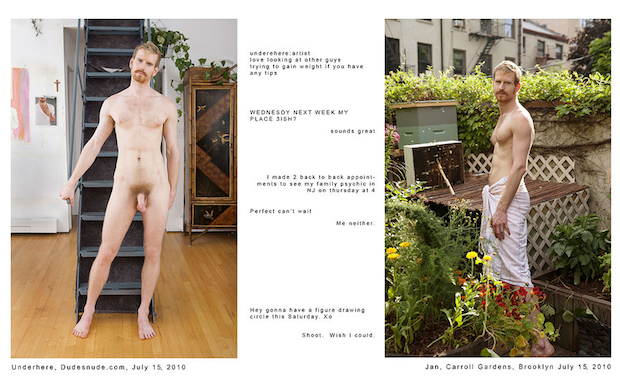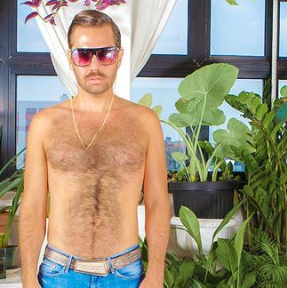Can art effectively question identity if it reinforces rather than questions stereotypes? Probably not, which makes any media attention for Sean Fader’s “SUP?” a little grating. Fader creates a series of “before” and “after” photos based on his dates with over 100 men he met off of gay dating sites and phone applications. Praised by Slate, and described by the Huffington Post as art which addresses “the complexities of online representations,” Fader’s project is wholly straightforward; he objectifies his models from beginning to end.
It’s perhaps Fader’s simplistic premise that has attracted attention in the first place. He enters the apartment of a willing male subject found through online/social media, and with no input from the subject, creates a “fantasy” photo. This photo sexualizes and categorizes him simultaneously. Fader’s only rule, that he not meet models before the first shoot, helped keep these subjects as nothing but sexual objects. Once this photo is taken, Fader and his muse go on a date, after which they “co- collaborate” on a second photo, a more “real” and representative picture of the model on display. We are led to assume that during these dates, the models talked about how they do not embody the stereotypes Fader envisioned for them, the second set of photos always seeming less sexy (i.e. less objectifying) than the first.
Viewers are never privy to exactly what took place on Fader’s “dates” (nor if he had sex with his models); we do, however, read judge-y arrogant texts he sends them, which are included in the space between his “before” and after” photos. Fader is ballsy enough to tell one model that “I am amazingly talented and charming…you won’t be able to take your hands off me,” proving that he might be aware how his “models” are objectifying and using him as much as he is using them, enlivened to be a muse for a hot artist guy.
This is the type of awareness and self-reflexivity that most of “SUP?” lacks, and so Fader’s “Fantasy vs. Reality” premise remains 100% percent about fantasy. Fantastically, all of Fader’s model’s are beautiful, whether they are being fetishzed or being “real.” What’s more, the second photos are not “real” photos of the subjects; they are models getting a competent cameraman to take expert photos of how sexy and “real” they are.
Take for instance, D-list user 20twenty22. In his first portrait, Fader constructs him as the ideal twink, shooting him perched on his kitchen counter, topless in a pair of yellow mesh shorts, red-sneakers, and a green baseball tilted to the left. The second photo, tagged with the model’s real name Evan Bolton Hill, might be more “real,” but it is also just a gay recitation of Terry Richardson’s gauzy hipster photos of the 1990’s. Here Evan is shot from above, on a bare mattress. His skimpy soccer look is replaced by an ensemble highlighting a striped sleeveless tank, (a necessity in any “hot” selfie these days), the baseball cap removed to reveal a Hitler youth bouffant. Evan winks queenily at the camera, exposing his pits, making clear his belief in his profile tag that “straight acting is code for self-hatred.” Although Evan’s second photo is more feminine, it isn’t much more “real” than the first. Evan remains an object, but this time he is the producer of his own objectification. He is still a pin-up, but he’s now self-aware.
Underhere’s “before” photo consists of the tall taut, blond, and bearded model naked in front of his stairs. His dick and bush catch the viewer’s eye first, followed by his “manly” sexy facial expression. Underhere is constructed as a daddy top, and likely a damn good one. Fader basically takes his subject’s “stats,” (height, weight, age, tribe) and uses these to sexually stereotype his subjects; after all these stats, one photo and a bunch of empty banter like “looking?” “more pics,” and “into?” is all the info gay men have before embarking on a sexual encounter. In his “after” photo, the setting has moved from the apartment to the garden, and Jan is found posing in profile, covered only by a towel. Jan comes off as less virile and more domestic. Now, he is your fantasy daddy and a sweet gentle man you can tend your garden with. Jan’s move from virility to domesticity, from fantasy fuck to fantasy boyfriend is all still fantasy, a simplistic version of a “real authentic” online persona that does not exist.
This false simplicity sometimes works in Fader’s favor. The work brings up questions about how others see us and how we see ourselves. Are we just the vessels of other people’s desire, aesthete objects, or are we complex beings who wish to be both objects and subjects, desirable and relatable? Can we find a way to talk about online dating/sex without reinforcing the stereotypes, impossible expectations, and insecurities around being wanted?
At its roots, “‘SUP?” could be seen as calling out the hypocrisy of a queer culture obsessed with labels and tribes if only by reinforcing them. In order to be “hot,” one must be legible as a sexual sub-category: twink, bear, top, daddy, otter, cub, leather bottom, etc. Most hypocritical in Fader’s work is that his way of calling out the issues with sexual “type-casting” is to reinforce them, literally turning strangers into the pin-up fantasy of their (assumed) sexual category.
And where is Sean Fader the artist in “’SUP?” Although he never appears in any of the photos, he is omnipresent. Without even seeing him, you know he’s hot. He has to be to land over 100 hot guys to “make beautiful art” with. (A note to straight readers: Unlike in straight culture, where being rich, famous, or talented can get you laid, in gay male culture, being hot, or at least fulfilling the requirements of a certain type remains a modus operandi.) And he is. Fader’s artist photo on his website might as well be used in SCRUFF marketing campaigns: Furry, bearded, topless but with shades, Fader embodies the hipster-art otter fantasy.
Sean Fader’s “SUP?” shows that we are living under a new erotic economy of realness. My own Grindr profile fetishes my furry chest, and my tagline states “looking for genuine encounters of all kinds.” What kind of “real encounters” am I looking for? In short, I want to be wanted for my idiosyncrasies, for being hairy and butch while having the voice and gesticulations of Harvey Fierstein. I want to be your sexual fantasy and my lived reality at the same time. In order to have a “genuine experience” we first have to market ourselves as objects, we must literally sing for our ‘sup’per. With every selfie we post on Instagram, every Tindr/Grindr message we send, we make concrete the idea that in order to buy the book, you gotta like the cover. In Fader’s case, this a book that is titillating but empty, high on style and pitifully low on substance.





{ 4 comments }
I’m a little torn on this series. (I must admit I know nothing about the work beyond this article) While I can understand and respect your point, I cant help but look at the series not as a political statement about sexuality or stereotypes but as a “post internet” depiction of what it is truly like to be himself in today’s world. Yes, he is overly sexualizing his subject, and yes, he has over sexualized himself, but anyone who interacts on a social media platform can understand and participates in the highly self curated depiction of themselves. So I’m not entirely sure that this work has anything to do with gay stereotypes, or being gay at all. If you look at the work as a critique on the culture of hyper self-awareness and narcissism that comes from creating avatars that interact with the world for us while we are away from internet, It works for me. Maybe it’s just me, but I thought I’d share anyways. Thanks for reading.
Seems like their real first names are given along with the neighborhood they live in [Bolton Hill is a neighborhood in Baltimore].
Hi Marc, Thank your for your critique. Not only of an art project but of the current state of gay male interaction. This project is superficial and agreed only furthers the desire/contempt matrix of gay cruising. We are left with the “authentic” souvenir of successful (?) sexual conquests that lead to an intimate interaction? It’s all a superficial document furthering its premise. But you touched upon much deeper cords. At least in gay bars there is human interaction. Apps and sites are only fantasy that can crumble immediately in person. The current disembodied state of affairs is building the fantasy beyond the beyond. How gay men interact online is a rich topic regarding technology, fantasy and embodiment. I’d love to continue that dialogue with a hairy chested Harvey talking butch dude. Oh, how that delivers discourse to the tired role taking. Let’s join radical fairies and take it back to nature. – Thomas
Hell, at least Nan Goldin gave us real sex.
Comments on this entry are closed.